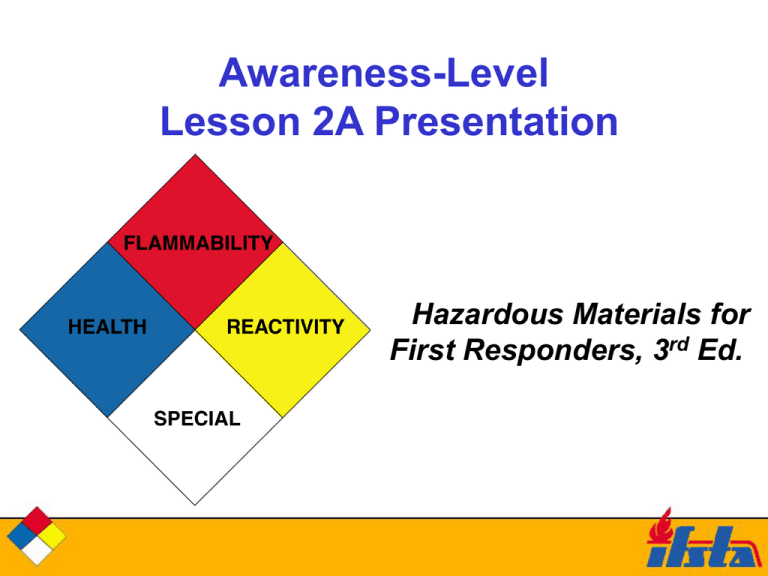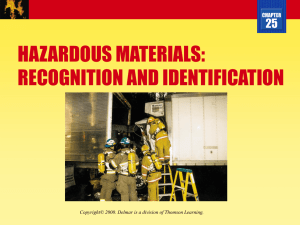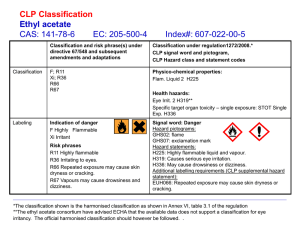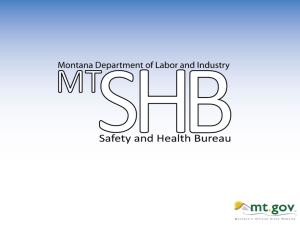Awareness-Level Lesson 2A Presentation
advertisement

Awareness-Level Lesson 2A Presentation Hazardous Materials for First Responders, 3rd Ed. Are Hazardous Materials Present? • What clues may indicate the presence of hazardous materials? • What information do container shapes, placards, labels, and other markings give first responders? This lesson will help answer these questions and aid you in identifying the presence of hazardous materials. Awareness Level 2A–2 Primary Clues Indicating Hazardous Materials • Occupancy types, locations, and pre-incident • • • • • • surveys Container shapes Transportation placards, labels, and markings Other markings and colors (nontransportation) Written resources Senses Monitoring and detection devices Awareness Level 2A–3 Purposes of Pre-Incident Surveys • • • • Reduce the number of on-site decisions Reduce oversights Reduce confusion Reduce duplication of efforts (1 of 2) Awareness Level 2A–4 Purposes of Pre-Incident Surveys • Identify the following items: – Exposures to people, property, environment – Types, quantities, and locations of hazardous materials – Dangers of the hazardous materials – Building features – Site characteristics – Possible access/egress difficulties – Inherent limitations of the responding organizations Awareness Level 2A–5 (2 of 2) Provisions Included in a LERP • Identifications – Reporting facilities – High-risk facilities – Likely routes for EHS transport • Methods/procedures to be followed in the event of any release of an extremely hazardous substance (EHS) (1 of 3) Awareness Level 2A–6 Provisions Included in a LERP • Designation of a community emergency coordinator and facility emergency coordinators • Procedures to be used by coordinators in notifying: – Public – Persons designated in the emergency plan • Methods for determining the occurrence of a release and the area or population likely to be affected by such release Awareness Level 2A–7 (2 of 3) Provisions Included in a LERP • Description of emergency equipment and facilities in the community • Evacuation plans • Training programs • Methods and schedules for exercising the emergency plans (3 of 3) Awareness Level 2A–8 Commercial Occupancies Containing Hazardous Materials • Fuel storage facilities • Gas/service stations and convenience stores • Paint supply stores • Plant nurseries, garden centers, and agricultural facilities • Pest control and lawn • • • • care companies Medical facilities Photo processing laboratories Dry cleaners Plastics and hightechnology factories (1 of 2) Awareness Level 2A–9 Commercial Occupancies Containing Hazardous Materials • Mercantile concerns • Chemistry • Warehouses • Industrial and utility laboratories Lumberyards Feed/farm stores Veterinary clinics Print shops plants • Port shipping facilities • Treatment storage disposal facilities • • • • (2 of 2) Awareness Level 2A–10 Hazardous Materials Found at Private Occupancies • Drain cleaners • Pesticides • Fertilizers • Paint products • Flammable liquids • Propane tanks Awareness Level 2A–11 Locations Likely to Have Hazardous Materials Incidents • • • • Schools Private property Material transfer sites Locations involving modes of transportation – – – – – Roadways Railways Waterways Airways Pipelines Awareness Level 2A–12 Bulk Packaging • Refers to a packaging, other than that on a vessel or barge, in which materials are loaded with no intermediate form of containment • Meets one of the following criteria: – Maximum capacity is greater than 119 gallons (450 L) as a receptacle for a liquid – Maximum net mass is greater that 882 pounds (400 kg) or maximum capacity is greater than 119 gallons (450 L) as a receptacle for a solid – Water capacity is 1,001 pounds (454 kg) or greater as a receptacle for a gas Awareness Level 2A–13 Nonbulk Packaging • Is smaller than minimum criteria established for bulk packaging • Composite packages and combination packages may also be classified as nonbulk packaging Awareness Level 2A–14 Atmospheric/Nonpressure Containers • Horizontal tank • Cone roof tank • Open top floating • Covered top floating roof tank • Covered top floating roof tank roof tank with geodesic dome • Lifter roof tank • Vapordome roof tank • Atmospheric underground storage tank Awareness Level 2A–15 Horizontal Tank Awareness Level 2A–16 Cone Roof Tank Awareness Level 2A–17 Open Top Floating Roof Tank Awareness Level 2A–18 Covered Top Floating Roof Tank Vents around the rim provide differentiation from cone roof tanks. Awareness Level 2A–19 Covered Top Floating Roof Tank with Geodesic Dome Awareness Level 2A–20 Lifter Roof Tank Awareness Level 2A–21 Vapordome Roof Tank Awareness Level 2A–22 Atmospheric Underground Storage Tank Awareness Level 2A–23 Low-Pressure Storage Tanks and Pressure Vessels • • • • • • Dome roof tank Spheroid tank Noded spheroid tank Horizontal pressure vessel Spherical pressure vessel Cryogenic-liquid storage tank Awareness Level 2A–24 Dome Roof Tank Awareness Level 2A–25 Spheroid Tank Awareness Level 2A–26 Noded Spheroid Tank Awareness Level 2A–27 Horizontal Pressure Vessel Awareness Level 2A–28 Spherical Pressure Vessel Awareness Level 2A–29 Cryogenic-Liquid Storage Tank Awareness Level 2A–30 Rail Tank Cars • • • • • Nonpressure tank car Pressure tank car Cryogenic liquid tank car Pneumatically unloaded hopper car High-pressure tube car Awareness Level 2A–31 Nonpressure Tank Car Awareness Level 2A–32 Pressure Tank Car Awareness Level 2A–33 Cryogenic Liquid Tank Car Awareness Level 2A–34 Pneumatically Unloaded Hopper Car Awareness Level 2A–35 High-Pressure Tube Car Awareness Level 2A–36 Cargo Tank Trucks • • • • • • • Nonpressure liquid tank Low-pressure chemical tank Corrosive liquid tank High-pressure tank Cryogenic liquid tank Compressed-gas/tube trailer Dry bulk cargo tanker Awareness Level 2A–37 Nonpressure Liquid Tank Awareness Level 2A–38 Low-Pressure Chemical Tank Awareness Level 2A–39 Corrosive Liquid Tank Awareness Level 2A–40 High-Pressure Tank Awareness Level 2A–41 Cryogenic Liquid Tank Awareness Level 2A–42 Compressed-Gas/Tube Trailer Awareness Level 2A–43 Dry Bulk Cargo Tank Awareness Level 2A–44 UN/DOT Hazard Classes • • • • Class 1: Explosives Class 2: Gases Class 3: Flammable and combustible liquids Class 4: Flammable solids, spontaneously combustible materials, and dangerous-whenwet materials • Class 5: Oxidizers and organic peroxides (1 of 2) Awareness Level 2A–45 UN/DOT Hazard Classes • Class 6: Poison (toxic) and poison inhalation hazard • Class 7: Radioactive materials • Class 8: Corrosive materials • Class 9: Miscellaneous dangerous goods (2 of 2) Awareness Level 2A–46 UN Commodity Identification Numbers • A four-digit number assigned to each hazardous material listed in the current ERG – Often displayed on placards, labels, orange panels, and/or white diamonds – May be preceded by the letters NA or UN – Also appears on shipping papers • Assists first responders in identifying the material and referencing it in the ERG (1 of 4) Awareness Level 2A–47 UN Commodity Identification Numbers • Display methods for UN commodity identification numbers – In a white rectangle inside a placard between the placard symbol and hazard class – In an orange rectangle beneath the placard – On a plain white square-on-point display configuration having the same outside dimensions as a placard (2 of 4) Awareness Level 2A–48 UN Commodity Identification Numbers (3 of 4) Awareness Level 2A–49 UN Commodity Identification Numbers • Must be displayed on the following containers/packages: – – – – – Rail tank cars Cargo tank trucks Portable tanks Bulk packages Vehicle containers containing large quantities of hazardous materials – Certain nonbulk packages (4 of 4) Awareness Level 2A–50 Parts of a DOT Placard Hazard Symbol Background Color Diamond shaped 4-Digit ID Number or Hazard Class Designation Hazard Class Number Awareness Level 2A–51 Containers on Which DOT Placards May Be Found • • • • • Bulk packages Rail tank cars Cargo tank vehicles Portable tanks Unit load devices over 640 cubic feet (18 m3) in capacity containing hazardous materials • Certain nonbulk containers Awareness Level 2A–52 DOT Placard Color Codes Explosive Oxidizer Health Hazard Water Reactive Awareness Level 2A–53 Flammable Nonflammable Gas DOT Symbols Explosive Poison Oxidizer Radioactive Corrosive Awareness Level 2A–54 Flammable Nonflammable Gas DOT Hazard Class 1: Explosives • Division 1.1 — Explosives with a mass explosion hazard • Division 1.2 — Explosives with a projection hazard (1 of 3) Awareness Level 2A–55 DOT Hazard Class 1: Explosives • Division 1.3 — Explosives with predominantly a fire hazard • Division 1.4 — Explosives with a minor explosion hazard (2 of 3) Awareness Level 2A–56 DOT Hazard Class 1: Explosives • Division 1.5 — Substances that have a mass explosion hazard but are very insensitive • Division 1.6 — Extremely insensitive detonating articles (3 of 3) Awareness Level 2A–57 DOT Hazard Class 2: Gases • Division 2.1 — Flammable gases • Division 2.2 — Nonflammable, nonpoisonous compressed gases (1 of 2) Awareness Level 2A–58 DOT Hazard Class 2: Gases • Division 2.3 — Gases toxic by inhalation • Oxygen placard — May be seen on containers with compressed gas or refrigerated liquid (2 of 2) Awareness Level 2A–59 DOT Hazard Class 3: Flammable and Combustible Liquids • Flammable placard • Gasoline placard (1 of 2) Awareness Level 2A–60 DOT Hazard Class 3: Flammable and Combustible Liquids • Combustible placard • Fuel oil placard (2 of 2) Awareness Level 2A–61 DOT Hazard Class 4: Flammable Solids, Spontaneously Combustible Materials, and Dangerous-When-Wet Materials • Division 4.1 — Flammable solids • Division 4.2 — Spontaneously combustible materials • Division 4.3 — Dangerous-when-wet materials Awareness Level 2A–62 DOT Hazard Class 5: Oxidizers and Organic Peroxides • Division 5.1 — Oxidizers • Division 5.2 — Organic peroxides Awareness Level 2A–63 DOT Hazard Class 6: Poison (Toxic) and Poison Inhalation Hazard • Division 6.1 — Poisonous material • Division 6.2 — Infectious substances (See labels) • Packing Group III (1 of 2) Awareness Level 2A–64 DOT Hazard Class 6: Poison (Toxic) and Poison Inhalation Hazard • Inhalation Hazard Placard • Harmful Placard (2 of 2) Awareness Level 2A–65 DOT Hazard Class 7: Radioactive Materials • Radioactive materials Awareness Level 2A–66 DOT Hazard Class 8: Corrosive Materials • Corrosive materials Awareness Level 2A–67 DOT Hazard Class 9: Miscellaneous Dangerous Goods • Miscellaneous placard • Dangerous placard Awareness Level 2A–68 Primary Hazard Characteristics of DOT Hazard Class Materials • Class 1: Explosives – Thermal – Mechanical • Class 2: Gases – – – – Thermal Asphyxiation Chemical Mechanical (1 of 5) Awareness Level 2A–69 Primary Hazard Characteristics of DOT Hazard Class Materials • Class 3: Flammable and combustible liquids – – – – Thermal Asphyxiation Chemical Mechanical (2 of 5) Awareness Level 2A–70 Primary Hazard Characteristics of DOT Hazard Class Materials • Class 4: Flammable solids, spontaneously combustible materials, and dangerous-whenwet materials – Thermal – Chemical – Mechanical • Class 5: Oxidizers and organic peroxides – Thermal – Mechanical (3 of 5) Awareness Level 2A–71 Primary Hazard Characteristics of DOT Hazard Class Materials • Class 6: Poison (toxic) and poison inhalation hazard – Chemical – Thermal • Class 7: Radioactive materials — Radiological hazards, including burns and biological effects (4 of 5) Awareness Level 2A–72 Primary Hazard Characteristics of DOT Hazard Class Materials • Class 8: Corrosive materials – Chemical – Thermal • Class 9: Miscellaneous dangerous goods – Thermal – Chemical (5 of 5) Awareness Level 2A–73 Characteristics of DOT Labels • Provide same information as vehicle placards • Are posted on packages • Are 3.9-inch (100 mm), square-on-point diamonds, that (with the exception of Class 7 labels) may or may not have written text • Require subsidiary risk labels for materials that meet the definition of more than one hazard class Awareness Level 2A–74 Unique DOT Labels • Explosive subsidiary risk • Flammable liquid (1 of 6) Awareness Level 2A–75 Unique DOT Labels • Infectious substances • Biohazard (2 of 6) Awareness Level 2A–76 Unique DOT Labels • Etiological agents (3 of 6) Awareness Level 2A–77 Unique DOT Labels • Radioactive I • Radioactive II • Radioactive III (4 of 6) Awareness Level 2A–78 Unique DOT Labels • Fissile • Empty (5 of 6) Awareness Level 2A–79 Unique DOT Labels • Magnetized material • Danger (cargo aircraft only) (6 of 6) Awareness Level 2A–80 DOT Chart 12 Markings • Hot • Marine pollutant (1 of 4) Awareness Level 2A–81 DOT Chart 12 Markings • Inhalation hazard • Fumigant (2 of 4) Awareness Level 2A–82 DOT Chart 12 Markings • Orientation • ORM-D (3 of 4) Awareness Level 2A–83 DOT Chart 12 Markings • ORM-D-Air • Inner packaging (4 of 4) Awareness Level 2A–84 Canadian Class 1: Explosives • Class 1.1 — Mass explosion hazard • Class 1.2 — Projection hazard but not a mass explosion hazard (1 of 3) Awareness Level 2A–85 Canadian Class 1: Explosives • Class 1.3 — Fire hazard and either a minor blast hazard or a minor projection hazard or both but not a mass explosion hazard • Class 1.4 — No significant hazard beyond the package in the event of ignition or initiation during transport (2 of 3) Awareness Level 2A–86 Canadian Class 1: Explosives • Class 1.5 — Very insensitive substances with a mass explosion hazard • Class 1.6 — Extremely insensitive articles with no mass explosion hazard (3 of 3) Awareness Level 2A–87 Canadian Class 2: Gases • Class 2.1 — Flammable gases • Class 2.2 — Nonflammable and nontoxic gases (1 of 2) Awareness Level 2A–88 Canadian Class 2: Gases • Class 2.3 — Toxic gases • Oxidizing gases (2 of 2) Awareness Level 2A–89 Canadian Class 3: Flammable Liquids • Flammable liquids Awareness Level 2A–90 Canadian Class 4: Flammable Solids, Substances Liable to Spontaneous Combustion, and Water-Reactive Substances • Class 4.1 — Flammable solids • Class 4.2 — Substances liable to spontaneous combustion • Class 4.3 — Water-reactive substances Awareness Level 2A–91 Canadian Class 5: Oxidizing Substances and Organic Peroxides • Class 5.1 — Oxidizing substances • Class 5.2 — Organic peroxides Awareness Level 2A–92 Canadian Class 6: Toxic and Infectious Substances • Class 6.1 — Toxic substances • Class 6.2 — Infectious substances Awareness Level 2A–93 Canadian Class 7: Radioactive Materials • Category I • Category II • Category III Awareness Level 2A–94 Canadian Class 8: Corrosives • Corrosives Awareness Level 2A–95 Canadian Class 9: Miscellaneous Products, Substances, or Organisms • Miscellaneous products, substances, or organisms Awareness Level 2A–96 Other Canadian Placards, Labels, and Markings • Danger • Elevated temperature (1 of 2) Awareness Level 2A–97 Other Canadian Placards, Labels, and Markings • Fumigation • Marine pollutant (2 of 2) Awareness Level 2A–98 Other Markings and Colors Indicating Hazardous Materials • Other markings, markings systems, labels, labeling systems, colors, color-codes, and signs may indicate the presence of hazardous materials – May be as simple as a stenciled word – May be site-specific Awareness Level 2A–99 Specialized Systems for Hazardous Materials • NFPA 704 • Common hazardous communications labels • International Organization for Standardization (ISO) • Globally harmonized system • Military markings • Pipeline identifications (1 of 2) Awareness Level 2A–100 Specialized Systems for Hazardous Materials • • • • Piping systems American Petroleum Institute (API) markings Pesticide labels Color codes (2 of 2) Awareness Level 2A–101 NFPA 704 Flammability Health Instability (1 of 8) Awareness Level 2A–102 NFPA 704 • Provides a method for indicating the presence of hazardous materials at: – – – – Commercial facilities Manufacturing facilities Institutional facilities Other fixed-storage facilities (2 of 8) Awareness Level 2A–103 NFPA 704 • Not designed for the following situations: – – – – – – Transportation General public use Nonemergency occupational exposures Explosive and blasting agents Chronic health hazards Etiologic agents, and other similar hazards (3 of 8) Awareness Level 2A–104 NFPA 704 • Benefits of NFPA 704 – Provides an appropriate signal to first responders that hazardous materials are present – Identifies the general hazards and degree of severity for health, flammability, and instability – Provides immediate information necessary to protect lives of the public and emergency response personnel (4 of 8) Awareness Level 2A–105 NFPA 704 • Health — Blue – – – – – 4 — Severe hazard 3 — Serious hazard 2 — Moderate hazard 1 — Slight hazard 0 — Minimal hazard (5 of 8) Awareness Level 2A–106 NFPA 704 • Flammability — Red – 4 — Flammable gases, volatile liquids, pyrophoric materials – 3 — Ignites at ambient temperatures – 2 — Ignites when moderately heated – 1 — Must be preheated to burn – 0 — Will not burn (6 of 8) Awareness Level 2A–107 NFPA 704 • Instability — Yellow – 4 — Capable of detonation or explosive decomposition at ambient conditions – 3 — Capable of detonation or explosive decomposition with strong initiating source – 2 — Violent chemical change possible at elevated temperature and pressure – 1 — Normally stable, but becomes unstable if heated – 0 — Normally stable (7 of 8) Awareness Level 2A–108 NFPA 704 • Special hazards – Located at 6 o’clock – Have no special background although white is most often used – May contain one of two special symbols – W — Unusual reactivity with water – OX — Oxidizer (8 of 8) Awareness Level 2A–109 Hazard Communications Labels and Markings • A variety of labeling systems are used to comply with the requirements of the OSHA Hazard Communication Standard (HCS) – – – – Many resemble NFPA 704 Communicate hazards under normal conditions May have differences in ratings Usually provided on vertically stacked bars Awareness Level 2A–110 Manufacturer’s Labels and Signal Words • Must be used by chemical manufacturers and importers • Must include one of four signal words if for consumer use: – – – – CAUTION — Minor health effects WARNING — Moderate hazards DANGER — Highest degree of hazard POISON — Highly toxic (pesticides) (1 of 2) Awareness Level 2A–111 Manufacturer’s Labels and Signal Words • Must include specific information: – Name and business address of the manufacturer, packer, distributor, or seller – Name of each hazardous ingredient – Statement of the principal hazard – Precautionary statements – Instructions for first-aid treatment – Instructions for special handling or storage – Statement “Keep out of the reach of children.” (2 of 2) Awareness Level 2A–112 Hazard Communication Symbols Biological Chemical Nuclear/ Radiological Awareness Level 2A–113 Carcinogen/ Cancer Canadian WHMIS Supplier Labels • Must appear on all controlled products at workplaces in Canada • Must have text in English and French • Must have the WHMIS hatched border (1 of 2) Awareness Level 2A–114 Canadian WHMIS Supplier Labels • Must contain: – – – – – – Product and supplier identifier Statement that MSDS is available Hazard symbols Risk phrases Precautionary measures First aid measures (2 of 2) Awareness Level 2A–115 Canadian WHMIS Workplace Labels • Must appear on all controlled products produced in a workplace or transferred to other containers by the employer • Must include: – Product identifier – Information for safe handling of the product – Statement that a MSDS is available Awareness Level 2A–116 Canadian WHMIS Hazard Classes • Class A: Compressed gas • Class B: Flammable and combustible material • Class C: Oxidizing material (1 of 3) Awareness Level 2A–117 Canadian WHMIS Hazard Classes • Class D: Poisonous and Infectious Materials – Class D, Division 1: Immediate and serious toxic effects – Class D, Division 2: Other toxic effects – Class D, Division 3: Biohazardous infectious materials (2 of 3) Awareness Level 2A–118 Canadian WHMIS Hazard Classes • Class E: Corrosive material • Class F: Dangerously reactive material (3 of 3) Awareness Level 2A–119 U.S. Military Fire Division Symbols • Division 1: Mass explosion – May also be used for Division 5: Mass Explosion — Very insensitive explosives • Division 2: Explosion with fragment hazard – May also be used for Division 6: Nonmass Explosion — Extremely insensitive ammunition (1 of 2) Awareness Level 2A–120 U.S. Military Fire Division Symbols • Division 3: Mass fire • Division 4: Moderate fire — No blast (2 of 2) Awareness Level 2A–121 U.S. Military Hazardous Chemical Markings • Wear full protective clothing (Set One) — Indicates the presence of highly toxic chemical agents that may cause death or serious damage to body functions – Mnemonic: “Red You’re Dead” • Wear full protective clothing (Set Two) — Indicates the presence of harassing agents – Mnemonic: “Yellow You’re Mellow” Awareness Level 2A–122 (1 of 3) U.S. Military Hazardous Chemical Markings • Wear full protective clothing (Set Three) — Indicates the presence of white phosphorus and other spontaneously combustible material – Mnemonic: “White is Bright” • Wear Breathing Apparatus — Indicates the presence of incendiary and readily flammable chemical agents that present an intense heat hazard (2 of 3) Awareness Level 2A–123 U.S. Military Hazardous Chemical Markings • Apply No Water — Indicates a dangerous reaction will occur if water is used in an attempt to extinguish the fire (3 of 3) Awareness Level 2A–124 U.S. Military Supplemental Chemical Hazards Markings • G-Type Nerve Agents • VX Nerve Agents • Incapacitating Nerve Agent (1 of 2) Awareness Level 2A–125 U.S. Military Supplemental Chemical Hazards Markings • H-type Mustard Agent/ Blister Agent • Lewisite Blister Agent (2 of 2) Awareness Level 2A–126 Pipeline Marker Information • Signal words CAUTION, WARNING, or DANGER • Information describing the transported commodity • Name and emergency telephone number of the carrier Awareness Level 2A–127 Pipeline Color Codes • • • • Yellow — High-hazard materials Green — Low-hazard liquids or liquid mixtures Blue — Low-hazard gases or gaseous mixtures Red — Fire-suppression materials Awareness Level 2A–128 Pipe Markings • Identify contents of the pipe • Additional information if special hazards are concerns • Arrows showing direction of flow within the pipe Awareness Level 2A–129 U.S. and Canadian Safety Color Codes • Red — Means Danger or Stop; is used on containers of flammable liquids, emergency stop bars, stop buttons, and fire-protection equipment • Orange — Means Warning; is used on hazardous machinery with parts that can crush or cut or energized equipment (1 of 3) Awareness Level 2A–130 U.S. and Canadian Safety Color Codes • Yellow — Means Caution; solid yellow, yellow and black stripes, or yellow and black checkers may be used to indicate physical hazards such as tripping hazards; also used on containers of corrosive or unstable materials • Green — Marks safety equipment such as firstaid stations, safety showers, and exit routes (2 of 3) Awareness Level 2A–131 U.S. and Canadian Safety Color Codes • Blue — Marks safety information signage such as labels or markings indicating the type of required personal protective equipment (PPE) (3 of 3) Awareness Level 2A–132 Summary • Awareness-level first responders need to be able to identify the possible presence of hazardous materials at an incident. There are many clues that first responders need to be aware of and knowledgeable about. • Awareness-level first responders should be familiar with transportation placards, labels, and markings as well as other clues such as container shapes and written resources. Awareness Level 2A–133 Awareness-Level Lesson 2A Presentation Hazardous Materials for First Responders, 3rd Ed.





